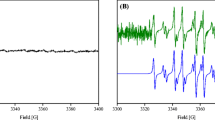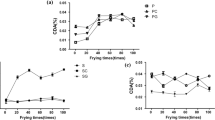Abstract
The present study investigated the lipid oxidation degree of soybean oil during regularly discontinuous 40 h-deep-frying process. Electron spin resonance (ESR) spectroscopy technique was applied to identify and quantify the formed radicals, along with evaluation of physicochemical parameters including acid value (AV), peroxide value (PV), p-anisidine value (p-AnV), polar compounds (PC), fatty acid composition and volatile profile. Results showed the AV, p-AnV, PC and free radical of frying oil samples increased significantly with the increasing frying time. The results of fatty acids showed that unsaturated fatty acid such as C18:1 and C18:2 decreased by 19.98% and 14.58%, respectively, with prolonged frying time, while the content of C16:1, trans C18:1 and C18:2 increased by 20.38%, 425% and 42.86%, respectively, when compared to the fresh oil samples. In contrast, the content of saturated fatty acid had little change. In total, 37 volatile compounds were detected revealing a complex aroma profile of frying soybean oil, composed of 15 aldehydes, 8 alcohols, 4 ketones, 4 acids, 5 alkanes and 1 furan. Principal component analysis and hierarchical clustering analysis indicated that hexanal, heptanal, (E)-2-hexenal, octanal, (E)-2-heptenal, nonanal, (E)-2-octenal, undecanal, (E,E)-2,4-heptadienal, (E)-2-decenal, 2-undecenal, (E,E)-2,4-decadienal, 1-pentanol, 2,2-dimethyl-3-hexanol, (Z)-2-dodecenol, 1-octen-3-ol, pentanoic acid, octanoic acid, nonanoic acid and 2-pentyl-furan may be potential markers for evaluating lipid oxidation of frying soybean oil.


Similar content being viewed by others
References
Akil E, Castelo-Branco VN, Calado V, Torres AG (2015) Oxidative stability and changes in chemical composition of extra virgin olive oils after short-term deep-frying of French fries. J Am Oil Chem Soc 92(3):409–421
Lim J, Jeong S, Oh IK, Lee S (2017) Evaluation of soybean oil-carnauba wax oleogels as an alternative to high saturated fat frying media for instant fried noodles. LWT Food Sci Technol 84:788–794
Juániz I, Zocco C, Mouro V, Cid C, Peña MPD (2016) Effect of frying process on furan content in foods and assessment of furan exposure of Spanish population. LWT Food Sci Technol 68:549–555
Alizadeh L, Nayebzadeh K, Mohammadi A (2016) A comparative study on the in vitro antioxidant activity of tocopherol and extracts from rosemary and ferulago angulata, on oil oxidation during deep frying of potato slices. J Food Sci Technol 53(1):611–620
Nieva-Echevarría B, Goicoechea E, Manzanos MJ, Guillén MD (2015) The influence of frying technique, cooking oil and fish species on the changes occurring in fish lipids and oil during shallow-frying, studied by 1H NMR. Food Res Int 84:150–159
Juárez MD, Osawa CC, Acuña ME, Sammán N (2011) Degradation in soybean oil, sunflower oil and partially hydrogenated fats after food frying, monitored by conventional and unconventional methods. Food Control 22(12):1920–1927
Feldstein AE, Lopez R, Tamimi AR, Yerian L, Chung YM, Berk M, Zhang R, McIntyre TM, Hazen SL (2010) Mass spectrometric profiling of oxidized lipid products in human nonalcoholic fatty liver disease and nonalcoholic steatohepatitis. J Lipid Res 51(10):3046–3054
Petra H, Hill BG (2013) Oxidized lipids activate autophagy in a JNK-dependent manner by stimulating the endoplasmic reticulum stress response. Redox Biol 1(1):56–64
Barden L, Decker EA (2016) Lipid oxidation in low-moisture food: a review. Crit Rev Food Sci 63(15):1812–1818
Zhang Q, Saleh AS, Chen J, Shen Q (2012) Chemical alterations taken place during deep-fat frying based on certain reaction products: a review. Chem Phys Lipids 165(6):662–681
Shahidi F, Zhong Y (2010) Lipid oxidation and improving the oxidative stability. Chem Soc Rev 39(11):4067–4079
Chang C, Wu G, Zhang H, Jin Q, Wang X (2019) Deep-fried flavor: characteristics, formation mechanisms, and influencing factors. Crit Rev Food Sci 59:1–19
Jerkovic I, Mastelic J, Tartaglia S (2007) A study of volatile flavour substances in dalmatian traditional smoked ham: impact of dry-curing and frying. Food Chem 104(3):1030–1039
Ramírez MR, Estévez M, Morcuende D, Cava R (2004) Effect of the type of frying culinary fat on volatile compounds isolated in fried pork loin chops by using SPME-GC-MS. J Agric Food Chem 52(25):7637–7643
Zhang Q, Qin W, Lin D, Shen Q, Saleh ASM (2015) The changes in the volatile aldehydes formed during the deep-fat frying process. J Food Sci Technol 52(12):7683–7696
Romano R, Giordano A, Grottaglie LL, Manzo N, Paduano A, Sacchi R, Santini A (2013) Volatile compounds in intermittent frying by gas chromatography and nuclear magnetic resonance. Eur J Lipid Sci Technol 115(7):764–773
Morales MT, Rios JJ, Aparicio R (1997) Changes in the volatile composition of virgin olive oil during oxidation: flavors and off-flavors. J Agric Food Chem 45(7):2666–2673
Temime SB, Campeol E, Cioni PL, Daoud D, Zarrouk M (2006) Volatile compounds from Chétoui olive oil and variations induced by growing area. Food Chem 99(2):315–325
Petersen KD, Jahreis G, Mechthild B, Fritsche J (2013) Chemical and sensory assessment of deep-frying oil alternatives for the processing of French fries. Eur J Lipid Sci Technol 115(8):935–845
Zhang Q, Wan C, Wang C, Chen H, Liu Y, Li S, Lin D, Wu D, Qin W (2018) Evaluation of the non-aldehyde volatile compounds formed during deep-fat frying process. Food Chem 243:151–161
Jung MY, Min DB (1990) Effects of α-, γ-, and δ-tocopherols on oxidative stability of soybean oil. J Food Sci 55(5):1464–1465
Hou JC, Jiang LZ, Zhang CW (2012) Effects of frying on the trans-fatty acid formation in soybean oils. Eur J Lipid Sci Technol 114(3):287–293
Naz S, Sheikh SH, Sayeed SA (2005) Deterioration of olive, corn and soybean oils due to air, light, heat and deep-frying. Food Res Int 38(2):127–134
Liao CH, Shaw HM, Chao PM (2008) Impairment of glucose metabolism in mice induced by dietary oxidized frying oil is different from that induced by conjugated linoleic acid. Nutrition 24(7–8):744–752
Huang CF, Lin YS, Chiang ZC, Lu SY, Kuo YH, Chang SL, Chao PM (2014) Oxidized frying oil and its polar fraction fed to pregnant mice are teratogenic and alter mRNA expressions of vitamin a metabolism genes in the liver of dams and their fetuses. J Nutr Biochem 25(5):549–556
Chiang YF, Shaw HM, Yang MF, Huang CY, Hsieh CH, Chao PM (2011) Dietary oxidised frying oil causes oxidative damage of pancreatic islets and impairment of insulin secretion, effects associated with vitamin e deficiency. Br J Nutr 105(9):1311–1319
AOCS (2011) Official methods and recommended practices of the American Oil Chemists’ Society, 6th edn. AOCS Press, Champaign
Liu Y, Wang Y, Cao P, Liu Y (2018) Quantitative determination of epoxy stearic acids derived from oxidized frying oil based on solid-phase extraction and gas chromatography. LWT Food Sci Technol 92:250–257
Liu Y, Wang Y, Cao P, Liu Y (2017) Combination of gas chromatography-mass spectrometry and electron spin resonance spectroscopy for analysis of oxidative stability in soybean oil during deep-frying process. Food Anal Method 11(5):1485–1492
Liu Y, Wang Y, Cao P, Liu Y (2017) Degradation of edible oil during deep-frying process by electron spin resonance spectroscopy and physicochemical appreciation. Eur J Lipid Sci Technol. https://doi.org/10.1002/ejlt.201700376
Nayak PK, Dash U, Rayaguru K, Krishnan KR (2016) Physio-chemical changes during repeated frying of cooked oil: a review. J Food Biochem 40(3):371–390
Olmedo R, Nepote V, Grosso NR (2014) Antioxidant activity of fractions from oregano essential oils obtained by molecular distillation. Food Chem 156:212–219
Chen H, Wang Y, Cao P, Liu Y (2017) Effect of temperature on thermal oxidation of palmitic acid studied by combination of EPR spin trapping technique and SPME-GC-MS/MS. Food Chem 234(1):439–444
Frankel EN (1998) Lipid oxidation, Woodhead Publishing in food science, technology and nutrition, 2nd edn. The Oily, Dundee
Kalua CM, Allen MS, Drjr B, Bishop AG, Prenzler PD, Robards K (2007) Olive oil volatile compounds, flavour development and quality: a critical review. Food Chem 100(1):273–286
Duflos G, Coin VM, Cornu M, Antinelli JF, Malle P (2006) Determination of volatile compounds to characterize fish spoilage using headspace/mass spectrometry and solid-phase microextraction/gas chromatography/mass spectrometry. J Sci Food Agric 86(4):600–611
Morales MT, Luna G, Aparicio R (2005) Comparative study of virgin olive oil sensory defects. Food Chem 91(2):293–301
Reiners J, Grosch W (1998) Odorants of virgin olive oils with different flavor profiles. J Agric Food Chem 46(7):2754–2763
Zhang Z, Li G, Luo L, Chen G (2010) Study on seafood volatile profile characteristics during storage and its potential use for freshness evaluation by headspace solid phase microextraction coupled with gas chromatography-mass spectrometry. Anal Chim Acta 659(1–2):151–158
Picardi SM, Issenberg P (1973) Volatile constituents of mushrooms (Agaricus bisporus). Changes which occur during heating. J Agric Food Chem 21(6):959–962
Fratini G, Lois S, Pazos M, Parisi G, Medina I (2012) Volatile profile of Atlantic shellfish species by HS-SPME GC/MS. Food Res Int 48(2):856–865
Liu X, Jin Q, Liu Y, Huang J, Wang X, Mao W, Wang S (2011) Changes in volatile compounds of peanut oil during the roasting process for production of aromatic roasted peanut oil. J Food Sci 76(3):C404–C412
Min HP, Min KJ, Yeo JD, Son HJ, Lim CL, Hong EJ, Hoh BS, Lee JH (2011) Application of solid phase-microextraction (SPME) and electronic nose techniques to differentiate volatiles of sesame oils prepared with diverse roasting conditions. J Food Sci 76(1):C80–C88
Lee JM, Kim DH, Chang PS, Lee JH (2007) Headspace-solid phase microextraction (HS-SPME) analysis of oxidized volatiles from free fatty acids (FFA) and application for measuring hydrogen donating antioxidant activity. Food Chem 105(1):414–420
Franciscojosé D, José G, Ramón C, Jesús G, Rosario R (2010) Characterisation by SPME-GC-MS of the volatile profile of a Spanish soft cheese P.D.O. Torta del Casar during ripening. Food Chem 118(1):182–189
Granato D, Santos JS, Escher GB, Ferreira BL, Maggio RM (2018) Use of principal component analysis (PCA) and hierarchical cluster analysis (HCA) for multivariate association between bioactive compounds and functional properties in foods: a critical perspective. Trends Food Sci Technol 72:83–90
Acknowledgements
This work was supported by the Natural Science Foundation of China (31671786), the Research Fund of National 13th Five-Year Plan of China (2016YFD0401404), and Northern jiangsu province science and technology projects (BN2016137).
Author information
Authors and Affiliations
Corresponding author
Ethics declarations
Conflict of interest
The authors declare that they have no conflict of interest.
Compliance with ethics requirements
This article does not contain any studies with human or animal subjects.
Additional information
Publisher's Note
Springer Nature remains neutral with regard to jurisdictional claims in published maps and institutional affiliations.
Electronic supplementary material
Below is the link to the electronic supplementary material.
Rights and permissions
About this article
Cite this article
Liu, Y., Li, J., Cheng, Y. et al. Volatile components of deep-fried soybean oil as indicator indices of lipid oxidation and quality degradation. Eur Food Res Technol 246, 1183–1192 (2020). https://doi.org/10.1007/s00217-020-03475-2
Received:
Revised:
Accepted:
Published:
Issue Date:
DOI: https://doi.org/10.1007/s00217-020-03475-2




